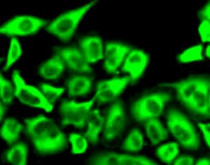ARG42658
anti-QPCT antibody
anti-QPCT antibody for ICC/IF,Western blot and Human,Mouse,Rat
Overview
| Product Description | Rabbit Polyclonal antibody recognizes QPCT |
|---|---|
| Tested Reactivity | Hu, Ms, Rat |
| Tested Application | ICC/IF, WB |
| Host | Rabbit |
| Clonality | Polyclonal |
| Isotype | IgG |
| Target Name | QPCT |
| Antigen Species | Human |
| Immunogen | Recombinant fusion protein corresponding to aa. 1-361 of Human QPCT (NP_036545.1). |
| Conjugation | Un-conjugated |
| Alternate Names | EC 2.3.2.5; Glutaminyl cyclase; Glutamyl cyclase; EC; QC; Glutaminyl-peptide cyclotransferase; GCT; sQC; Glutaminyl-tRNA cyclotransferase |
Application Instructions
| Application Suggestion |
|
||||||
|---|---|---|---|---|---|---|---|
| Application Note | * The dilutions indicate recommended starting dilutions and the optimal dilutions or concentrations should be determined by the scientist. |
Properties
| Form | Liquid |
|---|---|
| Purification | Affinity purified. |
| Buffer | PBS (pH 7.3), 0.02% Sodium azide and 50% Glycerol. |
| Preservative | 0.02% Sodium azide |
| Stabilizer | 50% Glycerol |
| Storage Instruction | For continuous use, store undiluted antibody at 2-8°C for up to a week. For long-term storage, aliquot and store at -20°C. Storage in frost free freezers is not recommended. Avoid repeated freeze/thaw cycles. Suggest spin the vial prior to opening. The antibody solution should be gently mixed before use. |
| Note | For laboratory research only, not for drug, diagnostic or other use. |
Bioinformation
| Database Links |
Swiss-port # Q16769 Human Glutaminyl-peptide cyclotransferase Swiss-port # Q9CYK2 Mouse Glutaminyl-peptide cyclotransferase |
|---|---|
| Gene Symbol | QPCT |
| Gene Full Name | glutaminyl-peptide cyclotransferase |
| Background | This gene encodes human pituitary glutaminyl cyclase, which is responsible for the presence of pyroglutamyl residues in many neuroendocrine peptides. The amino acid sequence of this enzyme is 86% identical to that of bovine glutaminyl cyclase. [provided by RefSeq, Jul 2008] |
| Function | Responsible for the biosynthesis of pyroglutamyl peptides. Has a bias against acidic and tryptophan residues adjacent to the N-terminal glutaminyl residue and a lack of importance of chain length after the second residue. Also catalyzes N-terminal pyroglutamate formation. In vitro, catalyzes pyroglutamate formation of N-terminally truncated form of APP amyloid-beta peptides [Glu-3]-amyloid-beta. May be involved in the N-terminal pyroglutamate formation of several amyloid-related plaque-forming peptides. [UniProt] |
| Cellular Localization | Secreted. [UniProt] |
| Calculated MW | 41 kDa |
Images (1) Click the Picture to Zoom In






